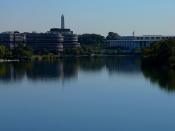AFTER the Revolution, chaos. Nothing could exceed the confusion and petty antagonisms of the thirteen states at the close of the Revolutionary War. The bond that had united their sympathies and joined their powers was loosened by the tidings of peace, and the victorious regiments marched home to discover that the feeling of Nationalism had been largely confined to the army, and that narrow, provincial sentiments prevailed in the local districts.
After the war of destruction must follow the era of construction. That remarkable group of men who had guided the affairs of the country in war now set themselves nobly to the great task of building a nation from the fragments that had survived the struggle.
It is necessary at the outset of this study of American politics to remember that the problem of our fathers was not only to provide the machinery of government, -- a national union with all of its subordinate and coordinate parts, -- but they must also organize and direct the motor force which would set this mechanism in motion, and ever accelerate or retard its impetus according to the needs of society.
Now for the creation of the mechanism, the model was at hand. It was an Anglo-Saxon model, evolved by fierce struggles between kings and barons, peoples and lords, armies and peasants, until the government of England stood forth, an example of constitutional centralization and local autonomy. It was the perversion, and not the demolishing of this ideal by a non-English monarch, that had led to the War of Independence. The experiences of the colonies and the vague and ultra-altruistic philosophy of the French school then in vogue, somewhat modified the pattern of English government written into our constitution. But on the whole, that is a purely Anglo-Saxon document.
The only portions...


